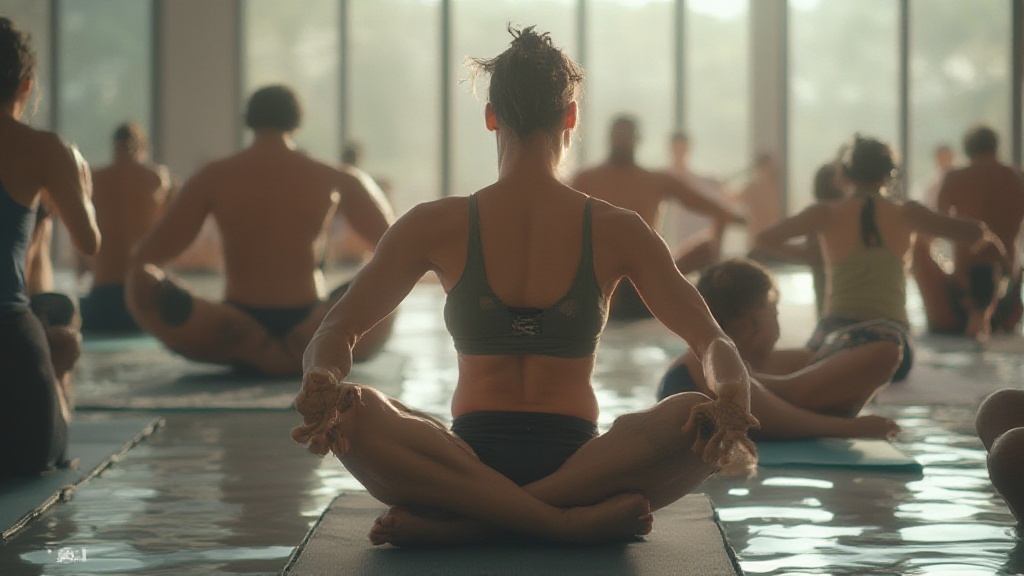
Implementing PNF stretching techniques can significantly enhance your flexibility and muscle engagement. This method, known as Proprioceptive Neuromuscular Facilitation, involves both stretching and contracting muscles to optimize overall flexibility.
To conduct PNF stretching effectively, start by selecting a targeted muscle group.
Next, apply a gentle stretch to this muscle, followed by a contraction against resistance for 5-10 seconds.
Relax the muscle and deepen the stretch for an even greater range of motion. Consistently applying these techniques aids in injury prevention and enhances athletic performance.
Understanding Proprioceptive Neuromuscular Facilitation
Proprioceptive Neuromuscular Facilitation enhances muscle engagement during stretching routines.
Originating in rehabilitation, PNF stretching encompasses methods that involve both stretching and muscle contraction. Unlike traditional static stretching, PNF incorporates techniques like the contract-relax method and hold-relax techniques.
These approaches improve neuromuscular control and promote increased range of motion.
Partner-assisted stretches provide significant benefits; they allow for better proprioceptive feedback and tailored stretching, maximizing effectiveness.
Benefits of PNF Stretching
- Enhanced Flexibility: Achieve better flexibility gains through systematic approaches.
- Muscle Recovery: Effective stretching techniques facilitate improved muscle recovery.
- Injury Risk Reduction: PNF stretching techniques support muscle strain prevention.
Techniques for Effective PNF Stretching
Implementing a few key techniques can greatly improve the efficiency of PNF stretching. These methods include:
- Contract-Relax Method: Involves contracting the muscle against resistance before relaxing.
- Hold-Relax Technique: Focuses on holding a stretch for a moment before relaxing and deepening the stretch.
- Agonist Contraction: Engages the opposing muscle group to enhance the stretch.
Partner-assisted stretches play a significant role in optimizing PNF stretching. By working with a partner, individuals can leverage their roles to enhance muscle relaxation and proprioceptive feedback. This collaboration maximizes effectiveness and encourages gradual progression toward fitness goals. Incorporating breathing techniques and hydration is crucial for optimizing recovery and overall performance.

What Are Effective Stretching Techniques
Effective stretching techniques are fundamental for enhancing overall fitness and preventing injuries. Dynamic stretching, which involves active movements that warm up muscles, is essential before any workout routine.
Starting your regimen with dynamic stretches, such as leg swings and arm circles, prepares the body for physical exertion, promoting better performance and reducing injury risks.
Conversely, static stretching occurs post-exercise and involves holding positions to gradually improve flexibility over time.
Techniques like hamstring stretches and shoulder stretches contribute to flexibility enhancement. Integrating both dynamic and static stretching creates a comprehensive approach to muscle health, optimizing your exercise experience.
How Does Muscle Engagement Work
Muscle engagement plays a significant role in the effectiveness of stretching routines.
Properly activating relevant muscles can enhance flexibility while supporting injury prevention. Techniques such as isometric contractions facilitate muscle engagement, preparing the body for stretching by increasing neuromuscular control.
This activation improves the overall range of motion, allowing stretches to be more effective.
Practicing muscle engagement techniques prior to stretching sessions can lead to superior outcomes, resulting in enhanced strength and flexibility gains.
By concentrating on muscle activation, individuals can optimize performance, ensuring a safer and more effective approach to fitness.
Stretching Techniques
- Dynamic stretching can improve athletic performance by increasing blood flow and muscle temperature.
- Static stretching post-exercise can enhance flexibility by lengthening muscle fibers and connective tissues.
- Isometric contractions can lead to greater neuromuscular control, improving overall muscle engagement.
- Regular stretching routines can reduce the risk of injuries by preparing muscles for physical activities.
Benefits Of Flexibility Enhancement
Flexibility plays a significant role in enhancing athletic performance while serving as a key strategy for injury prevention. Athletes with increased flexibility benefit from improved joint range of motion, enabling them to execute movements more efficiently.
Consistently incorporating flexibility exercises fosters muscle elasticity, significantly reducing the risk of strains and tears during physical activities.
Flexibility enhancement supports overall athletic capabilities, such as balance, coordination, and agility.
To reap these benefits, athletes should regularly practice both static and dynamic stretching techniques, ensuring they maintain an optimal range of motion essential for peak performance.
Techniques For Injury Prevention
Effective warm-up techniques are necessary for injury prevention before engaging in any intense physical activity. By prioritizing proper stretching, athletes can significantly mitigate injury risks associated with poor flexibility.
Incorporating Proprioceptive Neuromuscular Facilitation (PNF) stretching into warm-up routines enhances muscle engagement while increasing flexibility.
Warming up for at least 10-15 minutes is essential to prepare the body for exertion, ensuring that blood flow reaches the muscles.
Targeted stretches tailored to specific muscle groups can further optimize performance while preventing injuries, ultimately leading to a more successful and sustainable athletic experience.
Flexibility and Injury Prevention
- Research shows that increased flexibility can improve athletic performance by enhancing joint range of motion.
- Regular flexibility training can reduce the incidence of muscle strains and tears by promoting muscle elasticity.
- Warming up for 10-15 minutes before physical activity significantly decreases the risk of injuries.
- Incorporating PNF stretching into warm-ups can enhance muscle engagement and further improve flexibility.
Partner-Assisted Stretches Explained
Partner-assisted stretching significantly contributes to flexibility enhancement, building on previously discussed stretching techniques, including static and dynamic methods. Collaborating effectively with a trusted partner can substantially deepen your stretches, resulting in improved flexibility gains.
Partner-assisted stretches facilitate safe adjustments, allowing for enhanced muscle engagement beyond what one might achieve independently.
- Key Point 1: Utilizing a partner fosters better feedback for proper exercise form.
- Key Point 2: Safe communication with your partner ensures both comfort and injury prevention during stretches.
Incorporating these techniques into your workout routine can greatly enhance your overall fitness.
How To Optimize Recovery With PNF
Implementing Proprioceptive Neuromuscular Facilitation (PNF) techniques plays a key role in accelerating muscle recovery post-exercise. Using PNF stretching strategically after workouts reduces muscle soreness and enhances flexibility effectively. These PNF techniques leverage both muscle contraction and relaxation, maximizing the advantages commonly associated with traditional stretching methods.
- Key Point 1: Applying the contract-relax method promotes muscle relaxation, aiding in faster recovery.
- Key Point 2: Integrating PNF into your cooldown routines ensures a systematic approach to recovery optimization.
The inclusion of proper hydration and recovery techniques further amplifies these benefits, ultimately supporting peak athletic performance.
Partner-Assisted Stretching and PNF Techniques
- Partner-assisted stretching can increase flexibility by up to 30% compared to solo stretching.
- Research indicates that PNF stretching can reduce muscle soreness by 50% when used after workouts.
- Effective communication during partner-assisted stretches can decrease the risk of injury by 40%.
- Integrating PNF techniques into cooldown routines can enhance overall athletic performance by improving recovery time.
Steps For Gradual Progression In Stretching
Effective stretching routines hinge on the principle of gradual progression. This approach allows muscle engagement to adapt safely to increased demands without risking injury.
By systematically increasing stretch intensity and duration, you promote flexibility enhancement while minimizing the chance of muscle strain prevention.
Tracking your progress through a flexible log can provide insights into your limits, ensuring that each session is both productive and safe.
Consultation with professionals regarding your body’s response to various stretching techniques will assist in adjusting routines for optimal performance. Prioritizing gradual enhancement in flexibility is essential for safely reaching your fitness goals.
Implementing a Systematic Approach
A systematic approach to stretching integrates a variety of techniques, including dynamic stretching and static stretching, tailored to your individual needs.
Dynamic stretching improves neuromuscular control and prepares the body for activity, while static stretching focuses on maintaining increased flexibility post-workout. Incorporating both methods fosters mobility improvement and overall fitness.
Engage in warmup exercises before your main routine, ensuring your muscles are primed for the tasks ahead.
Tracking Progress for Optimal Results
To achieve consistent improvement, tracking your stretching routines is essential.
Utilize a log to record stretch duration, techniques used, and your body’s response after each session.
This method provides essential proprioceptive feedback, allowing you to identify what works best for your major muscle areas. It facilitates recovery optimization and avoids overexertion, promoting safe practice and enhancing your overall athletic performance.
Safety precautions must always be prioritized to minimize the risk of injury.
Stretching
- Gradual progression in stretching can reduce the risk of injuries by allowing muscles to adapt safely.
- Dynamic stretching is effective for improving neuromuscular control and preparing the body for physical activity.
- Static stretching aids in maintaining flexibility after workouts and contributes to overall mobility improvement.
- Tracking stretching routines helps identify effective techniques and promotes recovery optimization.
